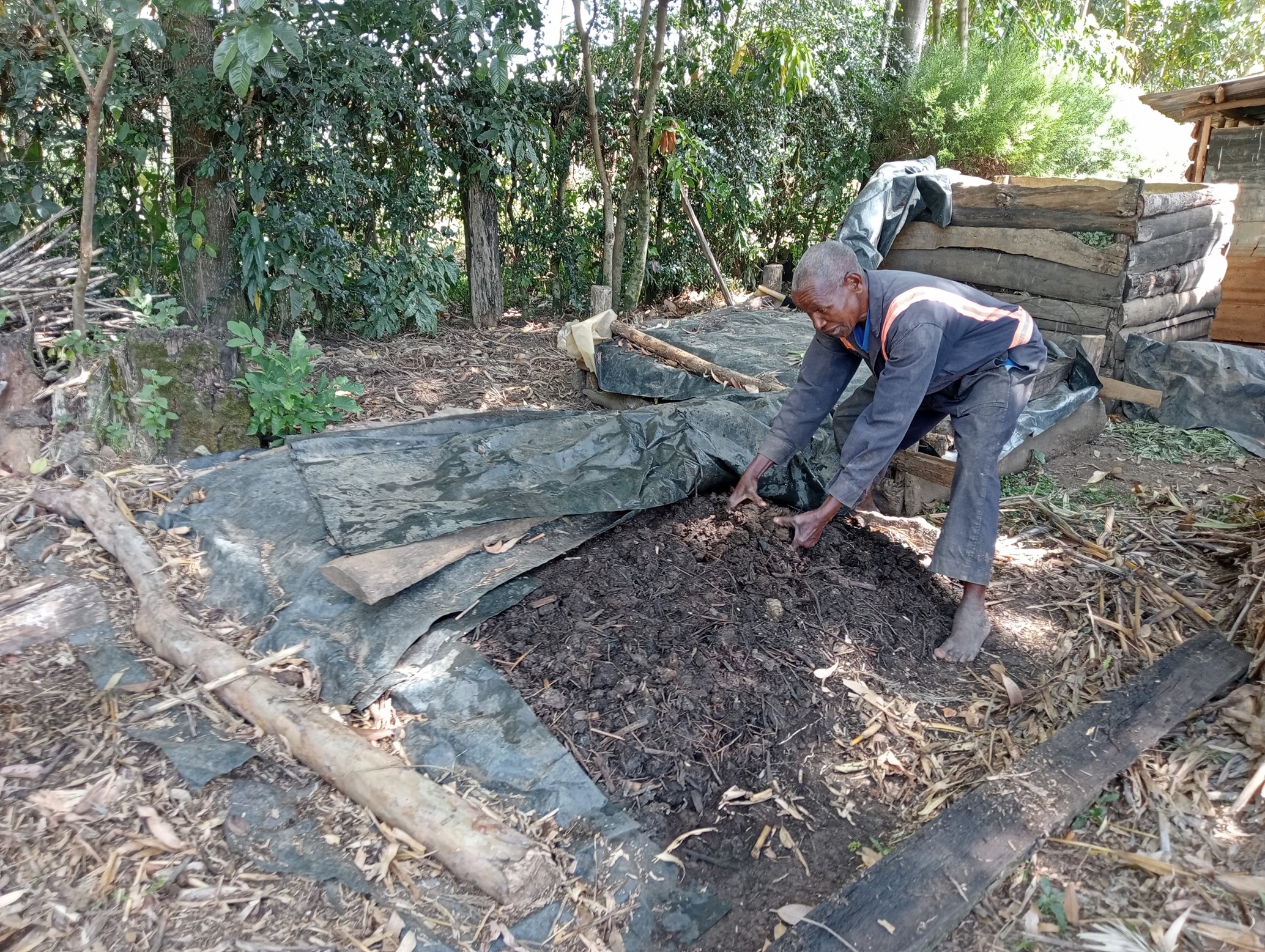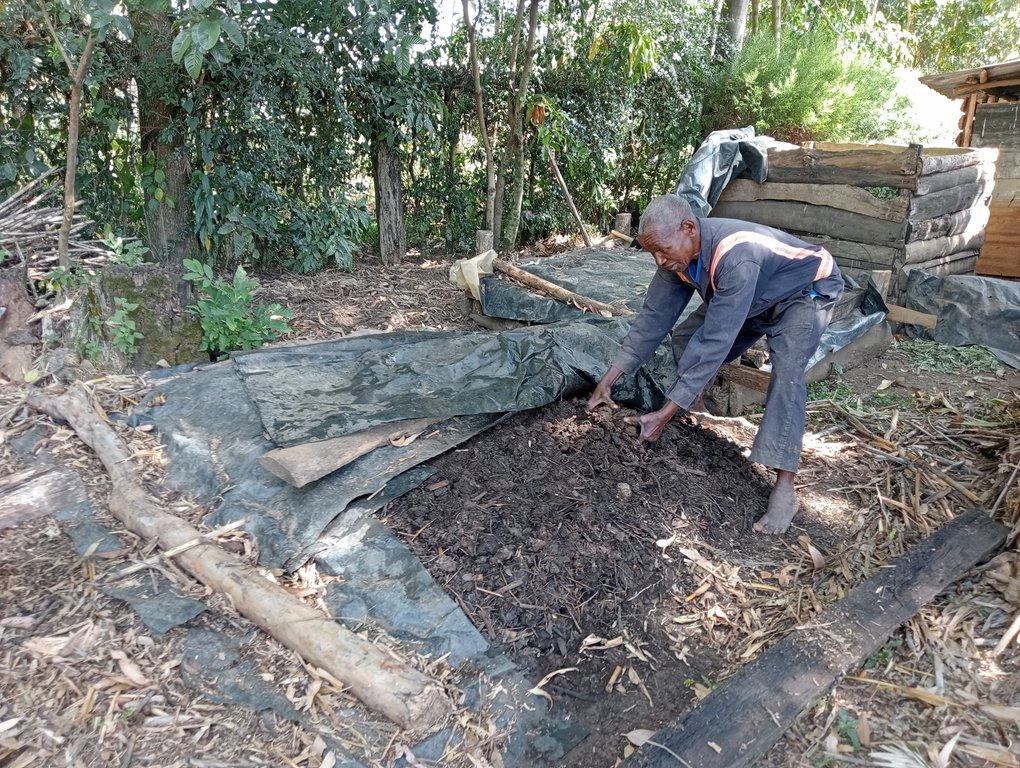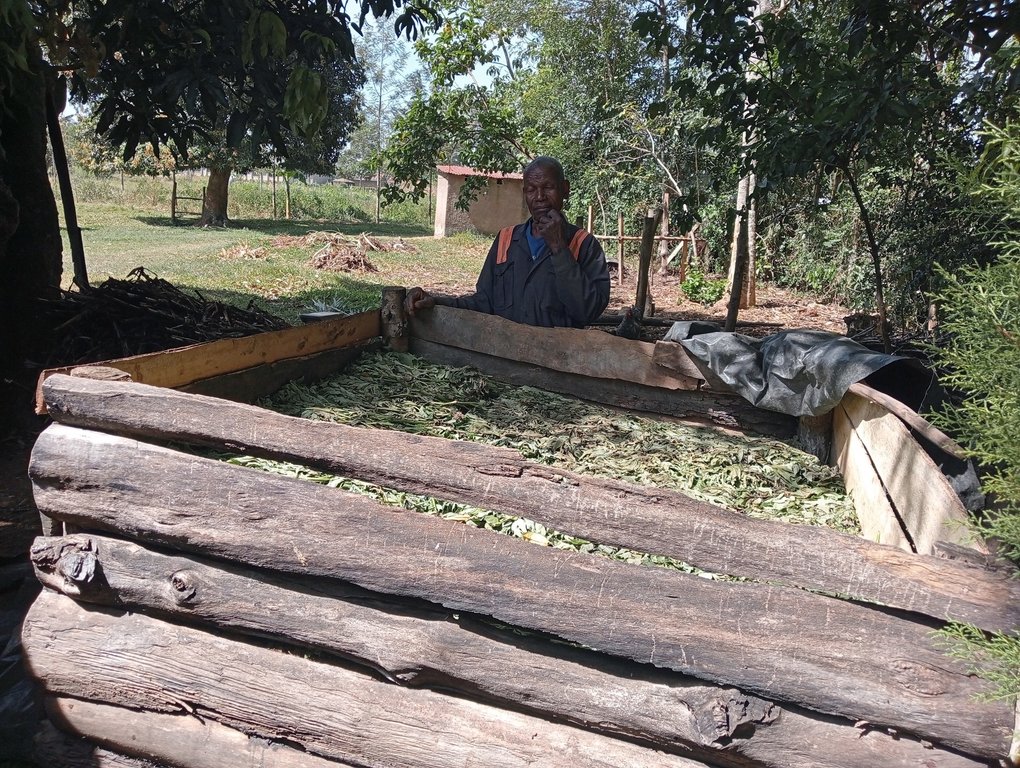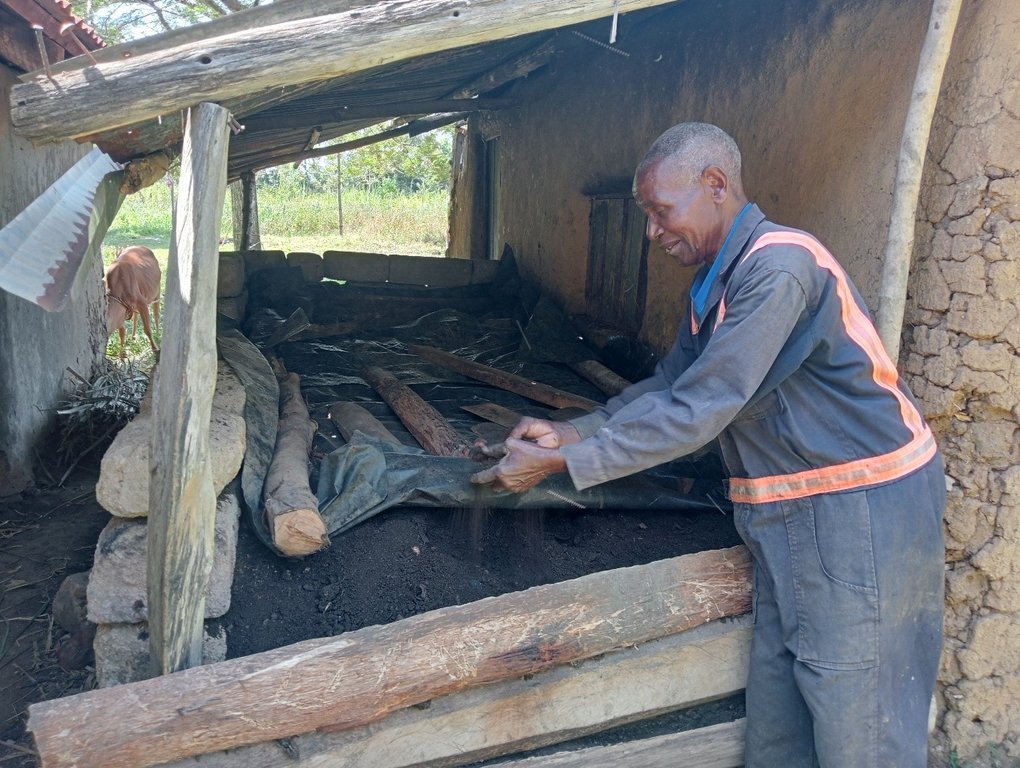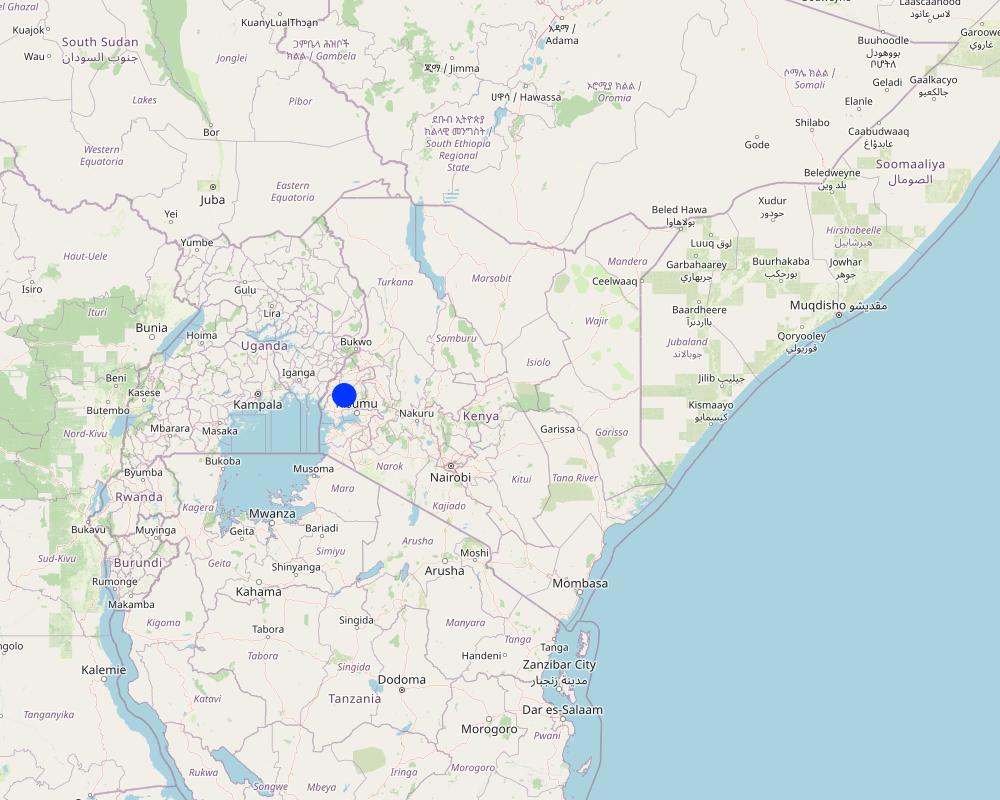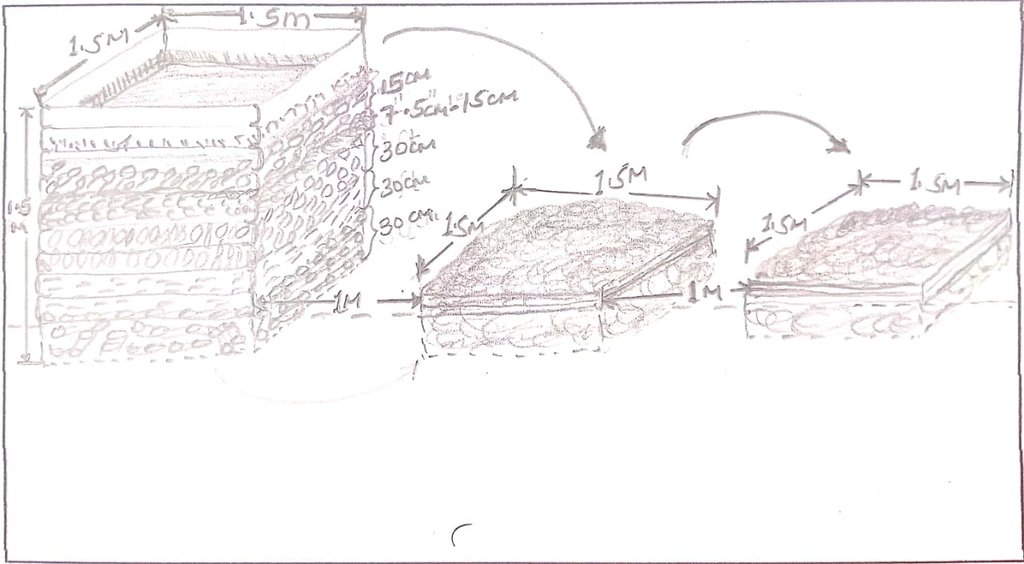Compost for organic waste management and improved crop yields [Кения]
- Создание:
- Обновить:
- Составитель: William Akwanyi
- Редакторы: George Onyango, Innocent Faith, Noel Templer, Tabitha Nekesa, Ahmadou Gaye, Siagbé Golli
- Рецензенты: William Critchley, Rima Mekdaschi Studer, Sally Bunning
Mbolea bora (Kiswahili)
technologies_6648 - Кения
Просмотреть разделы
Развернуть все Свернуть все1. Общая информация
1.2 Контактные данные специалистов и организаций, участвующих в описании и оценке Технологии
Ответственный (-ые) специалист (-ы)
землепользователь:
Anyanga Matthews George
Welthungerhilfe
Кения
Специалист по УЗП:
Специалист по УЗП:
Название проекта, содействовавшего документированию/оценке Технологии (если применимо)
Soil protection and rehabilitation for food security (ProSo(i)l)Название организации (-ий), содействовавших документированию/оценке Технологии (если применимо)
Deutsche Gesellschaft für Internationale Zusammenarbeit (GIZ)Название организации (-ий), содействовавших документированию/оценке Технологии (если применимо)
CIAT International Center for Tropical Agriculture (CIAT International Center for Tropical Agriculture) - Кения1.3 Условия, регламентирующие использование данных, собранных ВОКАТ
Составитель и ответственный(-ые) специалист(-ы) согласны с условиями, регламентирующими использование собранных ВОКАТ данных:
Да
1.4 Декларация по устойчивости описываемой Технологии
Вызывает ли описанная здесь Технология проблемы деградации земель настолько, что ее нельзя назвать природосберегающей?
Нет
Пояснения:
Farmers who have implemented the technology have recorded good harvests from their farms. The product of manure has improved their soils.
1.5 Ссылка на Анкету (ы) по Подходам УЗП (документируется с использованием ВОКАТ)
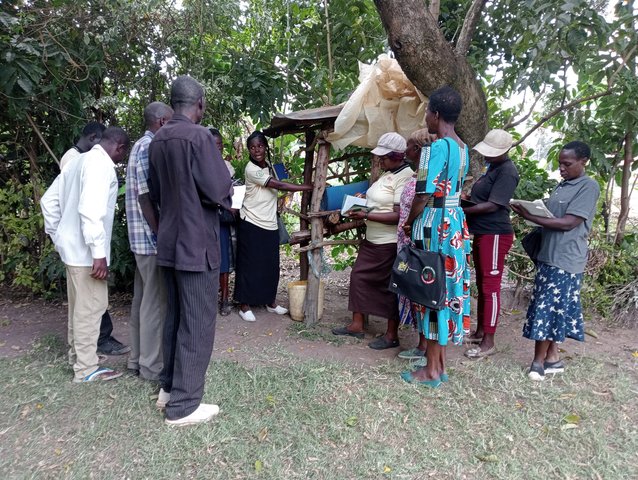
Community Resource Persons (CRP) in agricultural extension [Кения]
Community Resource Persons (CRP) form a farmer-to-farmer learning approach that bridges the gap in agricultural extension, increases farmers' access to agricultural information (SLM knowledge), and increases the adoption of SLM practices.
- Составитель: William Akwanyi
2. Описание Технологии УЗП
2.1 Краткое описание Технологии
Определение Технологии:
Composting with on-farm organic solid waste management improves the soil sustainably and raises crop yields.
2.2 Подробное описание Технологии
Описание:
Composting is a natural process of converting organic materials such as plant leaves, and food remains into a nutrient-rich soil-enhancing amendment called compost (if mainly from vegetative matter) or manure (if mainly from animal dung). It involves breaking organic matter down into humus/ compost by aerobic microorganisms - with by-products of water, heat, ammonia (NH3), and carbon dioxide (CO2). Humus is a dark and crumbly natural form of fertilizer applied to the soil to improve crop production. Composting is cost-effective since it can be made from locally available materials such as leaves, plant residues, food remains, cow dung, poultry droppings, animal urine, soil, etc. Composting is thus an on-farm solid waste management measure. When made correctly it can improve carbon sequestration in the soil (compost is carbon-rich) and prevent methane emissions (a greenhouse gas) since methane-producing microbes become inactive in aerobic conditions (in the presence of oxygen).
There are many ways of preparing compost. This method involves three key stages; mixing brown organic materials, such as twigs, and green materials, such as fresh leaves that are nitrogen-rich and moist. In the first stage, brown and green materials are layered, beginning with a 30 cm layer of twigs at the bottom, followed by a 30 cm layer of dry matter, such as maize straw chopped to a maximum of 7.5 cm. This is followed by a 30 cm layer of dry grass and dry leaves covered by a 7.5 cm – 15 cm layer of fresh cow dung. The fresh cow dung is covered by a 15 cm layer of fresh tithonia (an exotic plant) that is completely covered by a layer of ash and sprayed uniformly using 10 litres of animal urine and finally completely covered by a layer of soil or manure. All the above inputs except urine are sprayed with 10 – 20 litres of water. The pile is then completely covered with a black polythene sheet to help absorb heat, prevent the entry of rainwater, and prevent volatilization of nitrogen, i.e., the conversion of ammonium into ammonia gas, and left to decompose for 21 to 30 days.
The second stage involves mixing and transferring all the material except the twigs, to another space. The heap is again completely covered with a black polythene sheet to help absorb heat, prevent rainwater entry, and prevent nitrogen volatilization. It is again left to decompose for another 21 to 30 days. The third stage, like the second stage, involves completely mixing and transferring all the material from the second stage to another space and completely covering the heap with a black polythene sheet to help absorb heat and prevent the entry of rainwater. The contents are allowed to decompose for another 21 to 30 days, after which they are ready-to-use compost. The compost is stored under shade and covered with a black polythene sheet again to prevent nitrogen volatilization.
One heap of compost (first stage: 1.5 m by 1.5 m by 1.5 m) produces about 5 tonnes of ready-to-use compost. Composting takes about 90 days; hence, provided that all inputs are available, a farmer can produce compost 4 times each year from the same heaping point, i.e., about 20 tonnes. Normally, a 0.4-hectare farm requires about 20 tonnes of this compost. However, the amount varies from farm to farm depending on the conditions of the soil and the crop(s) to be grown. It is important that soil testing is done to determine the conditions of the soil to ensure that the compost is being used in the most effective manner.
Compost is carried to the farm on wheelbarrows and in buckets and is applied at the farm during planting time where a handful of compost is applied in the planting hole and mixed with soil before planting. It is again applied around the base of the crop and completely covered with soil. Preparation of compost in conservation agriculture situations could pose the problem of competition for plant material since plant material is used in conservation agriculture to cover the soil. To manage this, a farmer implementing both composting and conservation agriculture may have to acquire plant material for composting from other sources such as purchasing stover from other farmer who are not implementing conservation agriculture. In addition, the farmer could also use hedge trimmings as plant material for composting, especially if the farmer has a live fence.
2.3 Фотографии, иллюстрирующие Технологию
Комментарии к фотографиям:
Composting is a multi-stage process. The inputs/ materials in each stage must be completely covered with a black polythene sheet to help absorb heat, prevent the entry of rainwater, and prevent volatilization of nitrogen. The materials are allowed to decompose for at least 21 days in each stage before they are completely mixed and transferred to the next.
2.5 Страна/ регион/ места, где применяется Технология, информация о которых собрана в данной Анкете
Страна:
Кения
Административная единица (Район/Область):
Kakamega County in western Kenya
Более точная привязка места:
Elang'ata Village, Bulanda Sub-location, Imanga Location, Marama Central Ward, Butere Sub-county
Охарактеризуйте пространственное распространение Технологии :
- примененяется точечно/ на небольших участках
Технология применяется на ООПТ?
Нет
Пояснения:
The farm where the technology is implemented is not in a protected area.
Map
×2.6 Сколько лет применяется данная Технология
Год начала реализации:
2018
2.7 Внедрение Технологии
Укажите, как именно Технология УЗП была внедрена:
- как инновация (инициатива) землепользователей
- как часть традиционной системы землепользования (более 50 лет назад)
- через проекты/ внешнее вмешательство
Пояснения (тип проекта и т.д.):
For years, the farmer has been converting farm wastes into manure. However, the Soil Protection and Rehabilitation of Degraded Soil for Food Security (ProSoil) project came in and taught them an improved method of composting that takes a shorter time compared with the traditional method, and prevents loss of nutrients during composting.
3. Классификация Технологии УЗП
3.1 Основные цели и задачи реализации Технологии
- повышение производства
- снижение или предотвращение деградации земель, восстановление нарушенных земель
- адаптация к изменению климата / экстремальным погодным явлениям и их последствиям
- смягчение последствий изменения климата
- создание благоприятных экономических условий
3.2 Текущий(-ие) тип(-ы) землепользования на территории, где применяется Технология
Комбинированное землепользование в пределах одной и той же земельной единицы:
Да
Укажите сочетания типов землепользования (посевы / пастбища / деревья):
- Агро-лесо-пастбищное хозяйство

Пахотные угодья и плантации
- Однолетние культуры
- Многолетние (недревесные) культуры
- Древесные и кустарниковые культуры
Ежегодный урожай - Уточните культуры:
- кормовые культуры - травы
- зерновые культуры - кукуруза
- овощи - другие
- бобовые - бобы
- корневые / клубнеплодные культуры - маниока
Годовая система земледелия:
Кукуруза / сорго / просо, смешанные с бобовым
Многолетние (недревесные) культуры - Уточните культуры:
- банан / подорожник / абака
Древесные и кустарниковые культуры - Уточните культуры:
- авокадо
- другие фрукты
- манго, мангостан, гуава
- папайя
Число урожаев за год:
- 2
Поясните:
Long and short rain seasons
Применяются ли посевы в междурядьях?
Да
Если да, укажите, какие посевы применяются:
Maize and beans
Применяется ли севооборот?
Да
Если да, укажите:
Some sections of the farm are left fallow during the short rains to allow for soil regeneration.

Пастбищные угодья
Интенсивный выпас/ выращивание кормов:
- Стойловое содержание/ нулевой выпас
- Улучшенные пастбища
Вид животных:
- крупный рогатый скот - молочный
- cattle - dairy and beef (e.g. zebu)
- домашняя птица
Используется ли комплексное земледельческо-животноводческое хозяйство?
Да
Если да, укажите:
Cattle dung and poultry droppings are used as inputs in composting. Compost is applied on soil where livestock fodder is planted.
Продукты и услуги:
- economic security, investment prestige
- молоко
- manure as fertilizer/ energy production
- яйца
- мясо
Виды:
крупный рогатый скот - молочный
Счет:
2
Виды:
cattle - dairy and beef (e.g. zebu)
Счет:
3
Виды:
домашняя птица
Счет:
10
Пояснения:
There are assorted trees on the farm, and these provide litter which is an input in composting.
3.3 Изменилось ли использование земель в связи с внедрением Технологии?
Изменилось ли использование земель в связи с внедрением Технологии?
- Нет (см. пункт 3.4)
3.4 Водоснабжение
Обеспеченность водой участков, где реализуется Технология :
- богарные земли
Пояснения:
Crops are planted only during the rainy seasons since there is no irrigation.
3.5 Категория УЗП, к которой относится Технология
- Комлексное земледельческо-животноводческое хозяйство
- Комплексное управление почвенным плодородием
- Управление отходами/ сточными водами
3.6 Мероприятия УЗП, выполняемые в рамках Технологии

Агрономические мероприятия
- A2: Органическое вещество/ почвенное плодородие
- A6: Управление остатками
A6: Указать способ утилизации остатков:
А 6.3: собранные
Пояснения:
Plant residues, especially leaves and soft branches are collected and used as input in composting. However, some plant matter is retained in the farm to naturally decompose and turn into manure at the farm. The farmer does not collect plant residues from protected areas. He has planted tithonia at some sections of the hedges at his farm; this provides the main source of tithonia. However, he sometimes harvests tithonia from his neighbours' hedges upon request.
3.7 Основные проблемы деградации земель, на решение которых направлена Технология

ухудшение химических свойств почв
- Хп: Снижение плодородия и уменьшение содержания органического вещества (вызванное не эрозией, а другими причинами)
- Хк: подкисление
- Хз: загрязнение почв
Пояснения:
Covering of compost-making materials and the final compost reduces loss of nitrogen through volatilization of ammonium into ammonia gas. Compost raises the pH of soils when applied at the farm. Compost contains living organisms (bacteria and fungi) that degrade soil pollutants into non-toxic substances.
3.8 Предотвращение и снижение деградации земель, или восстановление нарушенных земель
Укажите цель Технологии по отношению к деградации земель :
- предотвращение деградации земель
- восстановление/ реабилитация нарушенных земель
Пояснения:
Compost improves soil structure and porosity. Compost balances soil pH.
4. Технические характеристики, мероприятия по практической реализации, вложения и стоимость
4.1 Технический рисунок, иллюстрирующий Технологию
Спецификация (пояснения к техническому рисунку):
Stage 1: about 30 cm deep under the ground, 1.5 m long by 1.5 m wide by 1.5 m high, including the 30 cm below the ground. Constructed using timber off-cuts (locally known as magogo) supported on posts at corners using nails. From bottom: 30 cm of twigs to extend some few inches above the ground to allow air circulation, 30 cm of dry matter e.g., maize straw chopped to 7.5 cm maximum, 30 cm dry grass and leaves, 7.5 cm - 15 cm layer of fresh cow dung, 15 cm layer of fresh tithonia, layer of ash, layer of soil or manure, black polythene sheet cover.
Stages 2 and 3: about 1-ft deep under the ground, 1.5 m long by 1.5 m wide, height depends on the volume of the material.
Allow space of no more than 1 m from one stage to the other for easy of mixing and transfer of materials from one stage to the next.
Автор:
William Onura
Дата:
26/01/2023
4.2 Общая информация по необходимым вложениям и стоимости
Уточните, как рассчитывались затраты и вложения:
- на технологическую единицу
Укажите единицу:
Heap of compost
Укажите единицы измерения (если необходимо):
1.5 m by 1.5 m by 1.5 m
другая/ национальная валюта (название):
KES
Если это необходимо, укажите обменный курс от доллара США к местной валюте (например, 1 доллар США = 79,9 бразильского реала): 1 доллар США =:
122,95
Укажите среднюю дневную заработную плату наемных работников:
200
4.3 Мероприятия, необходимые для начала реализации
| Деятельность | Время (сессия) | |
|---|---|---|
| 1. | Digging of pits | At least 3 months before planting time |
| 2. | Framework construction with off cuts | At least 3 months before planting time |
| 3. | Filling stage one with inputs | At least 3 months before planting time |
Пояснения:
Composting takes about 3 months; hence, the farmer should have the structures for composting at least 3 months before the planting time. A farmer can produce 20 tonnes of compost from 1 heap (1.5 m by 1.5 m by 1.5 m).
4.4 Вложения и затраты, необходимые для начала реализации
| Опишите затраты | Единица | Количество | Затраты на единицу | Общая стоимость на единицу | % затрат, оплаченных землепользователями | |
|---|---|---|---|---|---|---|
| Оплата труда | Framework construction | Man-days | 2,0 | 200,0 | 400,0 | 100,0 |
| Оплата труда | Filling inputs | Man-days | 1,0 | 200,0 | 200,0 | 100,0 |
| Оборудование | Jembe (hoe) | No. | 1,0 | 80,0 | 80,0 | |
| Оборудование | Spade | No. | 1,0 | 90,0 | 90,0 | |
| Оборудование | Fork hoe | No. | 1,0 | 70,0 | 70,0 | |
| Оборудование | Wheelbarrow | No. | 1,0 | 800,0 | 800,0 | |
| Оборудование | Hummer | No. | 1,0 | 100,0 | 100,0 | 100,0 |
| Оборудование | Handsaw | No. | 1,0 | 200,0 | 200,0 | 100,0 |
| Посадочный материал | Twigs | Wheelbarrow | 2,0 | 100,0 | 200,0 | 100,0 |
| Посадочный материал | Dry matter | Wheelbarrow | 6,0 | 50,0 | 300,0 | 100,0 |
| Посадочный материал | Dry grass and leaves | 90 Kg sack | 3,0 | 50,0 | 150,0 | 100,0 |
| Посадочный материал | Fresh tithonia | 90 Kg sack | 3,0 | 50,0 | 150,0 | 100,0 |
| Удобрения и ядохимикаты | Ash | 90 Kg sack | 0,4 | 200,0 | 80,0 | 100,0 |
| Удобрения и ядохимикаты | Animal urine | 10 litre container | 1,0 | 125,0 | 125,0 | 100,0 |
| Удобрения и ядохимикаты | Soil or manure | Wheelbarrow | 1,0 | 300,0 | 300,0 | 100,0 |
| Удобрения и ядохимикаты | Fresh cow dung | Wheelbarrow | 3,0 | 200,0 | 600,0 | 100,0 |
| Строительные материалы | Timber off-cuts | Pieces | 16,0 | 100,0 | 1600,0 | 100,0 |
| Строительные материалы | Wooden posts | Pieces | 4,0 | 50,0 | 200,0 | 100,0 |
| Строительные материалы | Nails (assorted sizes) | Kgs | 3,0 | 200,0 | 600,0 | 100,0 |
| Другие | Water | 20 litres container | 4,0 | 5,0 | 20,0 | 100,0 |
| Общая стоимость запуска Технологии | 6265,0 | |||||
| Общие затраты на создание Технологии в долларах США | 50,96 | |||||
Если землепользователем оплачено менее 100% затрат, укажите, кем покрывались остальные затраты:
ProSoil project
Пояснения:
The ProSoil project through Welthungerhilfe provided hoes, fork hoes, wheelbarrows, and spades to the farmers. The costs of these implements are KES 400/- for a hoe, KES 350/- for a fork hoe, KES 4,000/- for a wheelbarrow, KES 450/- for a spade, KES 500/- for a hummer, and KES 1,000/- for a handsaw. It is assumed that the farmer will be able to use the hoe, fork hoe, spade, hummer, and handsaw over a period of 5 years, and a wheelbarrow over a period of 10 years before these implements will have depreciated to a point where they will not be useable. The cost is thus spread over the years when the farmer will be able to use the implement.
4.5 Поддержание/ текущее обслуживание
| Деятельность | Сроки/ повторяемость проведения | |
|---|---|---|
| 1. | Turning at each stage | 21 - 30 days after start of each stage |
| 2. | Refilling at the first stage | At turning from the first stage |
| 3. | Distribution to the farm | When planting and at first weeding (i.e., 3rd week after planting) |
Пояснения:
Turning involves complete mixing and transfer of the inputs from one stage to the next. Compost is applied at the farm during planting time where a handful of compost is applied in the planting hole and mixed with soil before planting. It is again applied around the base of the crop and completely covered with soil.
4.6 Стоимость поддержания/ текущего обслуживания ( в год)
| Опишите затраты | Единица | Количество | Затраты на единицу | Общая стоимость на единицу | % затрат, оплаченных землепользователями | |
|---|---|---|---|---|---|---|
| Оплата труда | Complete mixing and turning from stage one to stage two and from stage two to stage three | Man-days | 4,0 | 200,0 | 800,0 | 100,0 |
| Оплата труда | Refilling with new materials at the first stage | Man-days | 1,0 | 200,0 | 200,0 | 100,0 |
| Оплата труда | Transfer to storage | Man-days | 2,0 | 200,0 | 400,0 | 100,0 |
| Оплата труда | Distribution to the farm | Man-days | 2,0 | 200,0 | 400,0 | 100,0 |
| Оборудование | Hoe | No. | 1,0 | 80,0 | 80,0 | |
| Оборудование | Fork hoe | No. | 1,0 | 90,0 | 90,0 | |
| Оборудование | Spade | No. | 1,0 | 70,0 | 70,0 | |
| Оборудование | Wheelbarrow | No. | 1,0 | 400,0 | 400,0 | |
| Посадочный материал | Dry matter | Wheelbarrow | 6,0 | 50,0 | 300,0 | 100,0 |
| Посадочный материал | Dry grass and leaves | 90Kg sack | 3,0 | 50,0 | 150,0 | 100,0 |
| Посадочный материал | Fresh tithonia | 90Kg sack | 3,0 | 50,0 | 150,0 | 100,0 |
| Удобрения и ядохимикаты | Ash | 90 Kg sack | 0,4 | 200,0 | 80,0 | 100,0 |
| Удобрения и ядохимикаты | Animal urine | 10 litre container | 1,0 | 125,0 | 125,0 | 100,0 |
| Удобрения и ядохимикаты | Soil or manure | Wheelbarrow | 1,0 | 300,0 | 300,0 | 100,0 |
| Удобрения и ядохимикаты | Fresh cowdung | Wheelbarrow | 3,0 | 200,0 | 600,0 | 100,0 |
| Другие | Water | 20 litres container | 4,0 | 5,0 | 20,0 | 100,0 |
| Общая стоимость поддержания Технологии | 4165,0 | |||||
| Общие затраты на поддержание Технологии в долларах США | 33,88 | |||||
Если землепользователем оплачено менее 100% затрат, укажите, кем покрывались остальные затраты:
ProSoil project
Пояснения:
The hoes, fork hoes, wheelbarrows, and spades provided by the ProSoil project through Welthungerhilfe are fixed assets and are used for years by the farmer before they can wear out. The farmer can use these implements for other work at the farm. The costs of these implements are KES 400/- for a hoe, KES 350/- for a fork hoe, KES 4,000/- for a wheelbarrow, and KES 450/- for a spade. It is assumed that the farmer will be able to use the hoe, fork hoe, and spade over a period of 5 years, and a wheelbarrow over a period of 10 years before these implements will have depreciated to a point where they will not be useable. The cost is thus spread over the years when the farmer will be able to use the implement. The twigs are reused during the refilling process since they take long to decompose.
4.7 Наиболее значимые факторы, влияющие на стоимость затрат
Опишите наиболее значимые факторы, влияющие на стоимость затрат:
Rate of man-days vary from one place to another. It is not easy to attach monetary value to some of the input e.g., animal urine, cow dung, and water.
Exchange rate for January 2023, source: European Commission/ InfoEuro online at https://commission.europa.eu/funding-tenders/procedures-guidelines-tenders/information-contractors-and-beneficiaries/exchange-rate-inforeuro_en
5. Природные и социально-экономические условия
5.1 Климат
Среднегодовое количество осадков
- < 250 мм
- 251-500 мм
- 501-750 мм
- 751-1000 мм
- 1001-1500 мм
- 1501-2000 мм
- 2001-3000 мм
- 3001-4000 мм
- > 4000 мм
Пояснения/ комментарии по осадкам:
Monthly rainfall variability is high with some months such as January recording less than 5 mm of total rainfall.
Укажите название соответствующей метеостанции:
Kakamega Meteorological Station
Агроклиматическая зона
- влажная
The climate in the area favours most agricultural activities.
5.2 Рельеф
Склоны (преобладающие):
- пологие (0-2%)
- покатые (3-5%)
- покато-крутые (6-10%)
- крутые (11-15%)
- очень крутые (16-30%)
- чрезвычайно крутые (31-60%)
- обрывистые (>60%)
Формы рельефа:
- плато/ равнины
- гребни хребтов/холмов
- склоны гор
- склоны холмов
- подножья
- днища долин
Зона высотной поясности:
- 0-100 м над уровнем моря
- 101-500 м н.у.м.
- 501-1000 м н.у.м.
- 1001-1500 м н.у.м.
- 1501-2000 м н.у.м.
- 2001-2500 м н.у.м.
- 2501-3000 м н.у.м.
- 3001-4000 м н.у.м.
- > 4 тыс. м н.у.м.
Укажите, приурочено ли применение Технологии к специфическим условиям:
- не имеет значения
Комментарии и дополнительные сведения по условиям рельефа/ топографии :
The farm is located at an area that is higher in altitude compared to other areas in the larger area. The average altitude for the area is 1,350m above sea level but the farm is at 1,401m above sea level.
5.3 Почвы
Средняя мощность почв:
- поверхностные (0-20 см)
- неглубокие (21-50 см)
- умеренно глубокие (51-80 см)
- глубокие (81-120 см)
- очень глубокие (> 120 см)
Гранулометрический состав (верхнего горизонта):
- средние фракции (суглинистый, супесчаный)
Гранулометрический состав (на глубине более 20 см):
- грубый крупнозернистый/ лёгкий (песчаный)
Содержание органического вещества в верхнем горизонте:
- среднее (1-3%)
Если возможно, приложите полное описание почв или укажите доступную информацию, например тип почв, рH/ кислотность почв, ёмкость катионного обмена, содержание азота, содержание солей и т.д.
Soil pH of most farms in the area ranges from moderately acid (5.50) to moderately alkaline (7.80).
5.4 Доступность и качество воды
Уровень грунтовых вод:
5-50 м
Доступность поверхностных вод:
хорошая
Качество воды (без обработки):
питьевая вода плохого качества (необходима обработка)
Качество воды относится к:
одновременно грунтовые и поверхностные воды
Является ли солёность воды проблемой?
Нет
Происходят ли периодические затопления территории?
Нет
Комментарии и дополнительная информация по качеству и количеству воды:
There are several boreholes in the area and according to interviews with some borehole owners, the depts are not more than 50 metres.
5.5 Биоразнообразие
Видовое разнообразие:
- средняя
Разнообразие местообитаний:
- средняя
Комментарии и дополнительная информация по биоразнообразию:
The area has high agrobiodiversity since most farms are under crops and trees.
5.6 Характеристика землепользователей, применяющих Технологию
Осёдлый или кочевой:
- Полукочевой
Рыночная ориентация производства:
- смешанный (натуральный / коммерческий)
Доходы из других источников:
- > 50% всех доходов
Относительный уровень достатка:
- средний
Индивидуальное или коллективное хозяйство:
- частное/ домовладение
Уровень механизации:
- ручной труд
- тягловая сила
Пол:
- женщины
- мужчины
Возраст землепользователей:
- молодёжь
- средний возраст
- пожилой
Укажите другие важные характеристики землепользователей:
The farmer uses the land together with his other family members.
5.7 Средняя площадь земель, используемых землепользователями с применением Технологии
- < 0,5 га
- 0,5-1 га
- 1-2 га
- 2-5 га
- 5-15 га
- 15-50 га
- 50-100 га
- 100-500 га
- 500-1000 га
- 1000-10000 га
- > 10000 га
Считается ли это мелким, средним или крупным хозяйством (по местным масштабам)?
- среднего размера
Пояснения:
Farmers with more than 2 ha in the area are considered to have large pieces of land since there is high level of land fragmentation in the area.
5.8 Собственность на землю, права на земле- и водопользование
Землевладелец:
- индивидуальная, не оформленная в собственность
- индивидуальная, оформленная в собственность
Право землепользования:
- аренда
- индивидуальное
Право водопользования:
- неограниченное (неконтролируемое)
- индивидуальное
Права на землепользование основаны на традиционной правовой системе?
Нет
Поясните:
Each landowner has full control of the way he/ she wants to use his/ her land.
Пояснения:
The farmer has an official ownership title for his piece of land. He also leases other people's pieces of land for farming. Water in the streams and springs is freely accessed without restrictions. There is a borehole in the neighbourhood, and the managers of this borehole have set rules for accessing the water thereat.
5.9 Доступ к базовым услугам и инфраструктуре
медицинское обслуживание:
- плохой
- средний
- хорошая
образование:
- плохой
- средний
- хорошая
технические консультации:
- плохой
- средний
- хорошая
занятость (вне хозяйства):
- плохой
- средний
- хорошая
рынки:
- плохой
- средний
- хорошая
электроснабжение:
- плохой
- средний
- хорошая
транспорт и дорожная сеть:
- плохой
- средний
- хорошая
водоснабжение и канализация:
- плохой
- средний
- хорошая
финансовые услуги:
- плохой
- средний
- хорошая
Пояснения:
The above rating varies from one village to the other.
6. Воздействия и заключительные положения
6.1 Влияние Технологии УЗП в пределах территории ее применения
Социально-экономическое воздействие
Продуктивность
производство сельскозяйственных культур
Количество до применения УЗП :
Less than 4
Количество после применения УЗП:
More than 8
Комментарий/ пояснения:
Quantity refers to the number of 90 Kg bags of maize produced per acre. Based on measurement by the farmer.
качество урожая
Комментарий/ пояснения:
Not easy to quantify. The crops do better compared to how they could do in the past, yet he does not use inorganic fertilizers. Based on estimation by the farmer.
производство кормов
Количество до применения УЗП :
2
Количество после применения УЗП:
3 - 4
Комментарий/ пояснения:
Quantity refers to harvesting cycles for nappier grass from the same farm. He applies compost on the pieces of land where he has grown fodder. The fodder does better than how it used to do before when he was not applying compost.
качество кормов
Комментарий/ пояснения:
He applies compost on the pieces of land where he has grown fodder.
производство продуктов животноводства
Количество до применения УЗП :
1 - 3
Количество после применения УЗП:
3 - 10
Комментарий/ пояснения:
Quantity refers to the amount of milk in litres from one cow. He gets more milk from his cows as compared to what he used to get before the SLM since applying compost on the pieces of land where he has grown fodder makes the fodder to grow faster. Milk production is often at the peak during early lactation months.
риск потери продуктивности
Количество до применения УЗП :
Over 50
Количество после применения УЗП:
Less than 10
Комментарий/ пояснения:
Quantity refers to the percentage probability of the crop failing to do well. Quote from the farmer, '... it was 50 50 getting any produce before I started using compost ...' meaning that there was high chance that the crop could fail due to poor soils. Compost is a rich source of organic matter; hence, ensure sustainable agricultural production.
Доходы и затраты
сельскохозяйственные издержки
Количество до применения УЗП :
Over 5,000
Количество после применения УЗП:
0
Комментарий/ пояснения:
Quantity refers to the amount of money in Kenya shillings spend on inorganic fertilizers in a season. The farmers no longer spend money inorganic fertilizers.
доходы хозяйства
Количество до применения УЗП :
Less than 2,000
Количество после применения УЗП:
20,000
Комментарий/ пояснения:
Quantity refers to the amount of money in Kenya shillings received from the sale of farm produce, including compost in a year. The farmer is able to sell surplus crop and animal products as a result of bumper harvest due to the use of compost on his farm.
разнообразие источников дохода
Количество до применения УЗП :
1 - 3
Количество после применения УЗП:
More than 3
Комментарий/ пояснения:
Quantity refers to household income sources, including sale of surplus farm produce and compost. The farmer is able to sell surplus crop and animal products, and other on-farm products such and compost.
объем работ
Количество до применения УЗП :
Over 5
Количество после применения УЗП:
Less than 1
Комментарий/ пояснения:
Quantity refers to the number of hours that the farmer can be free in any working day. A lot of work is involved in the preparation and maintenance of compost in order to achieve the desired results.
Социальное и культурное воздействие
продовольственная безопасность/ самообеспечение
Количество до применения УЗП :
About 3 months of purchasing maize
Количество после применения УЗП:
No months when there is total lack of food in the house
Комментарий/ пояснения:
Quantity refers to the number of months in a year when there is total lack of food in the house, and the farmer has to buy all the food required in the house. The soils at the farm have been enhanced; hence, the farmer grows a variety of crops. Food is available in the household to sustain the family from one harvest to the next.
знания в области УЗП/ деградации земель
Количество до применения УЗП :
10%
Количество после применения УЗП:
Over 90%
Комментарий/ пояснения:
Quantity refers to the estimated percentage of knowledge in SLM/ land management. Not only is the farmer equipped with skills on how to make compost but also with skills in other SLM technologies such as vermicomposting.
Экологическое воздействие
Почвы
влажность почв
Количество до применения УЗП :
Less than 10
Количество после применения УЗП:
20 or more
Комментарий/ пояснения:
Quantity refers to the farmer's estimated soil moisture content during the dry season when soil moisture challenges are expected to be high.
почвенный покров
Количество до применения УЗП :
30 - 50
Количество после применения УЗП:
60 - 80
Комментарий/ пояснения:
Quantity refers to the farmer's estimated percentage soil cover at the farm.
почвенное / подземное органическое вещество/ углерод
Комментарий/ пояснения:
Quantity refers to the farmer's estimated percentage of organic matter at the farm. Based on estimation by the farmer.
Биоразнообразие: растительность, животный мир
Растительный покров
Количество до применения УЗП :
30 - 50
Количество после применения УЗП:
60 - 80
Комментарий/ пояснения:
Quantity refers to the farmer's estimated percentage vegetation cover at the farm.
разнообразие флоры
Количество до применения УЗП :
About 3
Количество после применения УЗП:
More than 5
Комментарий/ пояснения:
Quantity refers to the number of plants (crops) that the farmer establishes at the farm.
полезные виды
Комментарий/ пояснения:
Not easy to quantify but the number of earthworms in the farm and bees visiting the farm to look for nectar has increased.
разнообразие местообитаний
Комментарий/ пояснения:
Not easy to quantify but the number of earthworms in the farm has increased which is an indication of increased habitats for different animals at the farm.
Укажите оценку внешних воздействий (измерений):
No recorded data is available for reference. All are estimates based on the farmer's explanation or as given by him.
6.2 Влияние Технологии за пределами территории ее применения
ущерб прилегающим полям
Количество до применения УЗП :
80
Количество после применения УЗП:
10
Комментарий/ пояснения:
Quantity refers to the probability of the neighbours' farms being burned because of available plant residues. The farmer collects residues from his neighbours' farms for use in composting. The neighbours could have burned the residues leading to death of useful microorganisms (bacteria and fungi).
воздействие парниковых газов
Комментарий/ пояснения:
Not easy to quantify. Composting improves carbon sequestration in the soil and by preventing methane emissions through aerobic decomposition, as methane-producing microbes are not active in aerobic conditions.
Укажите оценку внешних воздействий (измерений) :
No recorded data is available for reference. All are estimates based on the farmer's explanation or as given by him.
6.3 Подверженность и чувствительность Технологии УЗП к постепенным изменениям климата и экстремальным погодным явлениям/ стихийным бедствиям, связанным с изменением климата (в понимании землепользователей)
Постепенное изменение климата
Постепенное изменение климата
| Сезон | увеличение или уменьшение | Насколько успешно Технология справляется с этим? | |
|---|---|---|---|
| сезонные температуры | сезон дождей/ влажный сезон | снизилось | хорошо |
Экстремальные явления, связанные с изменением климата (стихийные бедствия)
Стихийные бедствия климатического характера
| Насколько успешно Технология справляется с этим? | |
|---|---|
| другие природные пожары | хорошо |
Пояснения:
Flammable plant residues are used as inputs in composting and, thus, the risk of fire is reduced.
6.4 Анализ эффективности затрат
Насколько получаемый результат сопоставим с первоначальными вложениями (с точки зрения землепользователей)?
Эффективность затрат в краткосрочной перспективе:
слабо позитивное
Эффективность затрат в долгосрочной перспективе:
очень позитивное
Насколько получаемый результат сопоставим с текущими расходами по поддержанию технологии (с точки зрения землепользователей)?
Эффективность затрат в краткосрочной перспективе:
очень позитивное
Эффективность затрат в долгосрочной перспективе:
очень позитивное
Пояснения:
Use of compost reduces the dependence on inorganic fertilizers.
6.5 Внедрение Технологии
- 11-50%
Если возможно, дайте количественную характеристику (число домохозяйств и/или площадь применения):
The project was implemented in the entire ward. Most farmers are preparing compost as advised in the ProSoil project.
Среди применяющих Технологию землепользователей, какова доля лиц, применяющих её по собственной инициативе, т.е. без какого-либо материального стимулирования со стороны?
- 91-100%
Пояснения:
Most farmers are able to implement since the investment cost is not very high.
6.6 Адаптация
Была ли Технология УЗП изменена в недавнее время с целью адаптации к меняющимся условиям среды?
Нет
6.7 Сильные стороны/ преимущества/ возможности Технологии
| Сильные стороны/ преимущества/ возможности по мнению землепользователей |
|---|
| With continued use of compost, there is no need for expensive inorganic fertilizers and pesticides that could also contaminate/ degrade the soil. |
| Composting is not capital intensive. |
| Сильные стороны/ преимущества/ возможности по мнению составителя или других ключевых специалистов |
|---|
| There is high production in the long run even without use of inorganic fertilizers. |
| Composting is not capital intensive. |
6.8 Слабые стороны/ недостатки/ риски Технологии и пути их преодоления
| Слабые стороны/ недостатки/ риски по мнению землепользователей | Возможные пути их преодоления/снижения? |
|---|---|
| Inputs such as tithonia are not easy to find. | Farmers can plant tithonia as hedges on their farms. |
| More labour intensive as compared to the traditional way of composting. | Farmers have to be committed. |
| Слабые стороны/ недостатки/ риски по мнению составителя или ответственных специалистов | Возможные пути их преодоления/снижения? |
|---|---|
| More labour intensive. | Proper planning/ scheduling of farmm activities. |
7. Справочные материалы и ссылки
7.1 Методы сбора/ источники информации
- выезды на места, полевые обследования
One visit at one farm
- опросы землепользователей
One farmer interviewed at his farm. Follow-up questions on phone.
- опросы специалистов/экспертов по УЗП
ProSoil team and project implementers from Welthungerhilfe consulted.
- данные, собранные из отчетов и достоверных документов
Kakamega County Integrated Development Plan, 2018-2022 and online sources reviewed.
Когда были собраны данные (на местах)?
26/01/2023
Пояснения:
One field visit and several follow-up consultations.
7.2 Ссылки на опубликованные материалы
Название, автор, год публикации, ISBN:
Comparative effectiveness of different composting methods on the stabilization, maturation and sanitization of municipal organic solid wastes and dried faecal sludge mixtures, Mengistu, T., Gebrekidan, H., Kibret, K. et al., 2018, Environ Syst Res 6, 5 (2018)
Где опубликовано? Стоимость?
Free download at https://doi.org/10.1186/s40068-017-0079-4
7.3 Ссылки на соответствующую онлайн-информацию
Название/ описание:
Composting Recycling Naturally: Simple Steps for Starting at Home
Адрес в сети Интернет:
https://scdhec.gov/sites/default/files/Library/OR-1705.pdf
7.4 Общие комментарии
1. Provide a function to be able to link the documented SLM to similar work that has been documented in other databases e.g., LandPortal, UNCCD, etc.
2. Some of the impacts (section 6) cannot be quantified.
Ссылки и модули
Развернуть все Свернуть всеСсылки

Community Resource Persons (CRP) in agricultural extension [Кения]
Community Resource Persons (CRP) form a farmer-to-farmer learning approach that bridges the gap in agricultural extension, increases farmers' access to agricultural information (SLM knowledge), and increases the adoption of SLM practices.
- Составитель: William Akwanyi
Модули
Нет модулей


